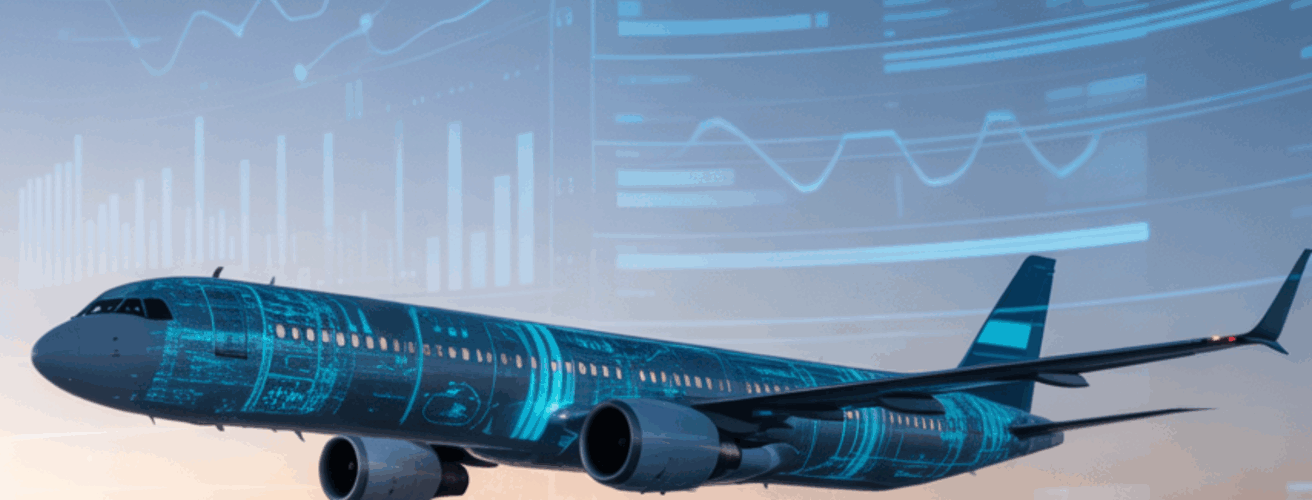By anticipating disruptions, optimizing maintenance schedules, and streamlining flight operations, predictive systems are helping airlines operate more intelligently and sustainably. In the sections that follow, let’s explore how predictive analytics transforms key operational areas from maintenance and crew scheduling to fuel efficiency and risk management and how solutions like Digitraly empower airlines to turn these insights into real-world efficiency gains.
The Emergence of Predictive Intelligence in Aviation
Predictive analytics has transitioned from novelty to mandate in contemporary aviation. It enables airlines to transform vast deluges of data from airplane sensors and weather patterns to pilot performance histories ; and predict problems before they become disruptions.
Why Predictive Analytics Powers Efficiency

Predictive Maintenance: Fix Before It Breaks
Technological malfunctions while flying can strand planes and cost airlines millions in lost time. Predictive maintenance systems monitor in real-time for the first signs of wear or anomaly within aircraft sensor information. Provided with advance warning of when things are likely to fail, maintenance crews can repair before faults happen.
Recent research demonstrates that predictive models can achieve up to 94-97% accuracy in predicting mechanical failures, highlighting the maturity of data-driven maintenance in aviation.
Delay Forecasting and Real-Time Optimization
Flight delays cost the aviation sector billions of dollars annually. Predictive analytics fixes this by considering real-time weather, air traffic, and airport congestion information. The system notifies operations staff about potential delays in advance, allowing for rerouting, gate changes, and pre-notification of passengers prior to flights — reducing inefficiency and enhancing customer satisfaction.
Crew Scheduling and Fatigue Management
Crew scheduling is a continuous dance between compliance and efficiency. Predictive systems utilize historical data, regulations, and operational forecasts to create optimized schedules that minimize fatigue and ensure labor compliance. Airlines that use predictive scheduling have demonstrated enhanced crew satisfaction and reduced turnover, which are key factors contributing to overall operational stability.
Fuel Optimization and Environmental Impact
Fuel efficiency is the most important driving factor towards aviation sustainability. Predictive models consider weather patterns, flight load, and air traffic to determine the most fuel-efficient routes and speeds. Airline companies that employ such solutions can save some percentage of fuel, minimizing emissions by design and reaching nearly their sustainability goals.
Bringing Predictive Insights into Real-World Impact
Investing in Integrated Data Systems
Data integration to drive accuracy in forecasting projections is dependent on robust data integration. Airlines now integrate sensor data, maintenance histories, and operational reports into integrated systems.
Building a Data-Driven Culture
Predictive analytics can only be deployed to its full potential when it is adopted company-wide. From engineers and pilots to operations managers, all teams need to be able to see how data influences their decisions. Some airline companies have pioneered the creation of data-trusting cultures, where analysis is integrated into day-to-day routines.
Risk Management and Transparency Building
Predictive systems also have a pivotal role in aviation risk management. Predictive systems track airspace traffic, geopolitical events, and adverse weather to predict safety risks prior to flight.
Transparency still reinforces trust. Transparency of performance information to regulators and investors by airlines reflects accountability and trust in forecasting systems.
Wrap Up
Predictive analytics is transforming air transport, turning uncertainty into actionable insight. From reducing maintenance downtime and optimizing flight routes to maximizing crew scheduling and fuel efficiency, airlines that use data-driven decision-making have a clear competitive advantage.
With Digitraly, carriers can harness the full power of AI-driven predictive analytics across their operations. Digitraly’s advanced intelligence platform seamlessly unifies operational data, transforms it into precise, real-time predictions, and empowers teams to make faster, smarter, and safer decisions in maintenance, scheduling, and fuel optimization.
Let’s build the future of predictive aviation together. Schedule a call with Digitraly and see how we can power your journey to aviation intelligence.



